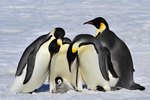Penguins are flightless birds that are better adapted to water than land. The Antarctic emperor penguin is the largest of all penguins at 3.7 feet tall and 60 to 90 lbs. The fairy, or blue, penguin of New Zealand and southern Australia is the smallest, standing 10 to 12 inches tall and weighing only 2.2 lbs. The 17 species of penguins have the same basic physical characteristics.
Body Type
Penguin bodies are elongated, sleek and streamlined, and are tapered at each end. Their bones are dense for strength and to easily dive underwater.
Color and Markings
Most mature penguins are black on their backs and white on the front. The fairy penguin, however, usually has slate-blue feathers. Beyond the base colors, many penguin species have coloring and markings that set them apart. The most unusual feature is found on the rockhopper and macaroni penguins – they have yellow or orange feathers that jut out from above their eyes, giving them a comical look.
Head and Bill
The head of a penguin is set on a short neck and has small eyes with round pupils and a third eyelid. Feathers cover holes where ears would normally be. Bills range in length and shape -- some are long and pointed, such as on the emperor penguin, and others are short and rounded, like those on the chinstrap penguin. The inside of the bill is lined with spines to prevent live prey from escaping.
Flippers
Penguins’ wings are called flippers since they aren’t used for flight, but instead are used in a flying motion to move underwater. They are flat and tapered, and covered in short feathers.
Legs and Feet
Penguins have short legs that only allow small steps or hops to get around on land. They are positioned back far enough on the body to allow penguins to walk upright. The feet are webbed for propelling penguins through water and are equipped with claws.
Tail
The tail of a penguin, according to SeaWorld, is “short and wedge-shaped, with 14 to 18 stiff tail feathers.” Some penguins, including the gentoo and adelie, have longer tail feathers, which they use to prop themselves up. All penguins use their tail to steer and brake underwater.
Feathers
Penguins are covered with short, interlocking and waterproof feathers. Muscles control the movement of the feathers, holding them tight to the body when swimming and out when on land to trap warm air next to the skin.
References
Photo Credits
-
Jupiterimages/Photos.com/Getty Images





